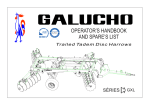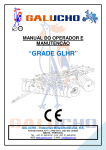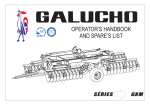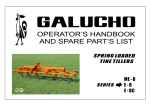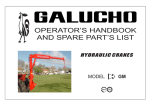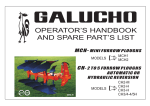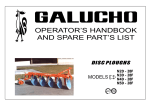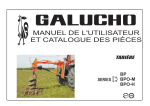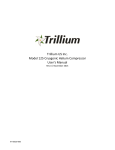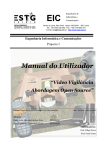Download M. O. GLHR UK
Transcript
OPERATOR’S HANDBOOK AND SPARE PART’S LIST SERIE GLHR INDEX RECOMMENDATIONS TO THE OWNER CONDITIONS OF GUARANTEE INNOVATIONS 1- EXPLANATORY NOTE 2- CONSTRUCTION 3- ASSEMBLY 4- ATTACHMENT TO THE TRACTOR 5- TECHNICAL SPECIFICATIONS (APPROX.) 6- ADJUSTMENTS 7- WORKING DEPTH 8- MAINTENANCE 9- REPLACING THE PARTS OF GREATEST WEAR 10- SECURITY REGULATIONS 11- PRATICAL ADJUSTMENTS ADVICES 12- ORDERING SPARE PARTS SPARE PART’S LIST 3 RECOMMENDATIONS TO THE OWNER CONDITIONS OF GUARANTEE The decision to opt for GALUCHO was a good one. The result of many years of experience, under the most difficult and diverse working circumstances, GALUCHO material gives complete satisfaction to its many thousands of users, both in Portugal and in over 40 countries, of different continents, where it is already at work. We are sure that, if used properly, and given the necessary care to maintenance, the machine you have just acquired will perform the efficient and economical job for which it was designed, and which a user has the right to expect from it. The present manual contains very important instructions concerning set-up, tuning, maintenance, etc., As well as diagrams and a parts list. Begin by reading it, attentively, in order to familiarise yourself with the material. Then, keep it in secure and accessible place, for future consultation. If you still have doubts, consult the distributor who supplied the machine, or else consult us, as it is in all of our interests that you be satisfied with, and obtain maximum yield from your purchase. Recordings and technical data are indicated by name and subject to alterations without previous notification. 1- Our company guarantees all the agricultural equipment which is manufactured for a period of two years from the date of invoice. 1.1- This guarantee only includes the supply of replacement parts or components which are proved to be deficiently made or installed, and does not cover the payment of manual labour or displacement costs. 1.2- Any components considered by this company to the worn out, are excluded from the guarantee. 1.3- The guarantee given by this company will not include any parts not made by themselves, for examples tyres, which will remain the exclusive responsibility of their respective manufacturer, and this decision will be communicated to the claimant with all its consequences. GALUCHO - Indústrias Metalomecânicas, S.A. Av. Central, N.º 4 2705-737 S. João das Lampas - Sintra, Portugal Telef.:21 960 85 00 Fax:21 960 85 99 www.galucho.pt [email protected] 2- Reasons for immediate loss of guarantee: 2.1- Use of equipment in abnormal working conditions, or used with tractors of different powers than those indicated, in each different case, in our technical literature. 2.2- The substitution of pieces or accessories for others not made or recognised by this company. 2.3- Any repair or alteration done, during the period of guarantee, without our knowledge or authorisation. 3- All claims against the guarantee must be communicated to us by the respective retail agents, by means of a claim form. The pieces or accessories, which are the objects of complaint, must be sent for examination to our Technical Services and Quality Department. If the reasons for the complaint are confirmed and accepted, new pieces will be supplied, or their value credited to the customer, if already sent. 4 - The powers indicated in our catalogues and other literature as necessary for certain equipment of our construction, may vary according to the different types and states of the earth, the experience of the operator, the state of the tractor, and the adherence of the latter to the terrain on which it is working. 5 - This company can only accept the return of equipment to the factory, within a maximum of 15 days after the sending of the invoice, providing it has not been used in a working situation, it is not a model already withdrawn from production, or if it is still part of our production range, there have been no alterations made to the model. 6 - In compliance with regulations determined in the Directiva Máquinas/CE (Machines Directive/CE), this company: 6.1 - Manufactures its machines respecting the relevant safety regulations, namely with respect to the protection of moving parts; 6.2 - Supplies a certificate of conformity, referring to the norms and regulations fulfilled; 6.3 - Supplies a user's manual and catalogue of parts for each machine. NOTE: Every Galucho dealer is obliged to supply the eventual consumer with: - The safety devices, fixed or detachable, relevant to each machine; - The certificate of conformity and the user's manual with a catalogue of parts for each machine. 7 - We recommend the reading of our pamphlet: “General Conditions of Sale and Payment”. 8 - For any necessary clarifications, please consult our Commercial Services. 4 GALUCHO-IND. METALOMECÂNICAS, S.A. continually attempts to perfect its products, reserving itself the right, at any time, to make alterations to the design and/or to the specifications of construction materials, and its respective components, without incurring, as a result, the obligation to apply these alterations to machines previously made and sold. F C INNOVATIONS D A C C C C B H B 1- EXPLANATORY NOTE Although all the models of GLHR series are dimensionaly different -20 to 32discs- the assembly, adjustments, maintenance, etc. details are the same. The existing structural differences may be verified in the characteristics table or in the drawings of the corresponding components. 2- CONSTRUCTION Chassis - Rigid set, composed by longitudinal and transverse profiles, meant to support the disc gangs, the lifting and transportation gear, as well as other components - same of them supplied as optional. On the front part are located the supports where the transverse bar will be connected , on which is fixed the entire set of the tractor-hook shaft. Disc Gangs - Front and rear, each one of them composed by one or more axles on which the discs, disc spacers and bearings are assembled, all of them supported by a spar, on which the scrapers are assembled. The front right gang and. the rear left gang have . the concavity of the discs turned to the right side . Apposite, on the front left gang and rear right gang the same concavity is turned to the left side. In all the cases, the adjustable scrapers are assembled behind the discs . . G D A E Fig. 1 A- Frame or Chassi; B- Front gang; C- Rear gang; D- Transversal bar; E- Drawbar; F- Leaf spring; G- Hoses support; H- Scrapers Fig. 2 A- Front gang; B- Rear gang; C- Screws D- Finishing disc Lifting and transportation wheels - it is composed by an articulated set, started by a double effect cylinde and on which are assembled 2 tyre wheels. This set includes a hydraulicl valve for automatically regulating working depth. 5 3- ASSEMBLY D B C . When disassembled, the GLHR disc harrow series is composed by: - Frame or Chassis. - 2 disc gangs. - Transverse offset bar with spring plates and fixed drawbar. - Telescopic bar. - 2 tyre wheels. - Set of hoses. - Cylinder for driving the raising gear - The hose at the front is linked to the tractor, the one at the back depth control valve at the opening facing the front of the harrow. - Depth control valve - Attach the hose going to the tractor to the lateral opening. . 3.8- Put the 2 wheels with tyres in place and . tighten them up. 4- ATTACHEMENT TO THE TRACTOR Its assembly must be carried out according to the following procedures: 3.1- On flat ground, put the two gangs parallel so that the centres of their axles are approximately at a distance of: - 2.50 m in case of models with 18-20-22-24, and 26 discs. - 2.78 m in case of models with 28 and 32 discs. 3.2- Keep the 2 gangs upright, using for this purpose props or pieces of wood prepared before hand and a suitable length, along with chocks on the discs so that the gangs not turn. Remove the 4 screws of each gang, which will hold it to the frame. 3.3- With a forklift, or by other suitable method, place the frame on the gangs, adjusting the corresponding apertures and tighten the 4 screws of each gang. Also place the pin in each gang. 3.4- Pass the telescopic positioner between lower part of the frame and the upper part of the lifting and carrying gear. Taking in consideration that the longest part of the positioner is connected to the rear gang, taking as a reference the support on which the system of opening and closing the gangs will be fixed to it , be it mechanical or hydraulic. A Fig. 3 A- Lift an transporting gear; B- Hydraulic cylinder for opening and closing the lifting gear; C- Telescopic positioner; D- Fixing support for telescopic positioner After assembling the disc harrow check if everything is as it should be. For that purpose, connect all the hoses 2 by 2, to their corresponding circuits. With the disc gangs lifted, the cylinder which commands its leveling is also tested. Should any of the circuits fail to function properly, check the tightness connections of the hoses, since these may be switched, either on the cylinders or on the tractor. 3.5- Connect the hydraulic cylinder for opening and closing the gangs, or the mechanical command on their supports. 3.6- Link the transverse bar to the 2 intermediate bore-hole .of the front support of the frame. Connect the leaf spring clevis to the threaded regulator of the tubular positioner, or, optionally to a hydraulic cylinder. 3.7- Fasten the hoses - Cylinder for opening and closing the gangs The two hoses are linked to the tractor. - Cylinder for levelling the gangs - The two hoses are linked to the tractor. 6 5- TECHNICAL SPECIFICATIONS DISCS NUMBER OF BEARINGS MODELS WORKING WIDTH TYRES WEIGHT REQUIRED POWER (kg) (Hp) NUMBER DIAM. X THICK. (") (mm) (m) GLHR-20-24 20 24 - 610x6 6 (3+3) 2,25 2-10.0/75-15-12T 1740 75-95 GLHR-22-24 22 24 - 610x6 6 (3+3) 2,45 2-10.0/75-15-12T 1830 80-100 GLHR-24-24 24 24 - 610x6 8 (4+4) 2,70 2-10.0/75-15-12T 1940 85-105 GLHR-26-24 26 24 - 610x6 8 (4+4) 2,90 2-10.0/75-15-12T 2030 95-115 GLHR-20-26 20 26 - 660x6 6 (3+3) 2,25 2-10.0/75-15-12T 1830 90-110 GLHR-22-26 22 26 - 660x6 6 (3+3) 2,45 2-10.0/75-15-12T 1910 95-115 GLHR-24-26 24 26 - 660x6 8 (4+4) 2,70 2-10.0/75-15-12T 2030 100-120 GLHR-26-26 26 26 - 660x6 8 (4+4) 2,90 2-10.0/75-15-12T 2120 110-130 GLHR-28-26 28 26 - 660x6 8 (4+4) 3,15 2-10.0/75-15-12T 2400 120-140 GLHR-32-26 32 26 - 660x6 8 (4+4) 3,60 2-10.0/75-15-12T 2570 130-150 7 5- ADJUSTMENTS B D C 6.1- Decentralizing the harrow - Both the transverse bar and the adjusting plates linking its drawbar, have a number of apertures which permit different work positions for the harrow relative to the tractor. For both, using the 2 central apertures, the work position must be correct. . If necessary, however the harrow can be decentralized considerably by altering the fastening position of the plates on the transverse bar, both right and left. If a smaller amount of decentralization is required, the angle at which the drawbar is fixed can be changed by moving it right if one wants to shift the harrow to the left, or vice-versa. 6.2- Height of the attachment - The transverse offset bar may be connected at 3 different heights, as demanded by the type of ground and the conditions of work performance. Thus, for normal work and average conditions, connect it to the central holes; under hard conditions and for a deeper penetration, use the upper hole; on soft grounds and for a lighter penetration, connect it to the lower hole. A . Fig. 4 A- Bar for immobilizing wheels; B- Hydraulic bar for depth control; C- Bushing for depth adjustment; D- Pin for fixing the immobilizing bar 6.3- The gangs angling can be either with mechanical, or hydraulic device. As we above mentioned system are interchangeable its eventual change can be done anytime. Mechanical opening of the gangs - With the disc gangs n the ground and the harrow linked to the tractor, the operator pulls a cord which puts into action the release catch. Then he slowly moves the tractor forward until the gangs reach the required opening. At this moment the operator releases the cord, in order to enable the release catch to fix itself in one apertures of the adjusting bar. In the case of it being required to reduce the angle or to put the gangs in a parallel position, the operation is repeated, reversing tractor slowly. A Fig. 5 A- Adjuster; B- Leaf spring clevis B Hydraulic opening - Move the lever which controls the respective cylinder, extending it or shortening it, according to the required opening system is fixed on the rear gang and on the telescopic positioner which, at its ends, has an extension with apertures. The possibility of varying the fixing of these apertures, as referred to in 3.4, gives the possibility of changing the maximum angle of opening of the front gang (25º), and with regard to the rear gang, respectively 30º, whatever is the system of opening used. 6.4 Working depth - Directly determined by the opening of the gangs. The further they are open, the more the discs will penetrate, which requires that more power available, and vice-versa. When the opening is adjusted, the positioning of the wheels regulates the work depth through the action of an automatic hydraulic valve, which works through the adjustable position of the bushing. When the required depth is found the flow of oil from the cylinder controlling the wheels, keeps the work depth uniform and unaffected by the variations in difficulty of the strip being work. Without overloading the respective hydraulic cylinder, the wheels can be kept completely up or down, using the pin in the appropriate aperture in the immobilizing bar. Whilst working, the same pin must always be placed in the respective support, because if placed in one of the other apertures, the system can be damaged when the hydraulic cylinder is working. 6.5 Longitudinal levelling of the gangs - Acting on the adjuster at the end of the tubular positioner, or if required, as an extra, at the hydraulic cylinder that can substitute it, the levelling and consequent penetration of the harrow gangs can be altered. Increasing the length of the adjuster, which has screw thread to the right and left, will cause the rear gang penetrate deeper. 8 Reducing the length will make penetration more at the front gang and less at the rear. If there is a hydraulic cylinder, the same effect can be obtained by operating the appropriate command lever, which changes the cylinder to the required length. . 6.6 Transverse levelling of the gangs - In disc offset harrows, especially in trailers, the discs on the right penetrate deeper and so wear out. more quickly. This unevenness can be compensated for by the applications as an extra of an eccentric to hold the right wheel, which acts as depth adjuster, permitting transverse levelling of the gangs in three different positions. 6.7 Disc scrapers - The scrapers should work as close as possible to the surface of the discs, but without touching them (5 to 10 mm distance). As they are assembled individually, on the longeron of respective gang, they can be adjusted independently, by moving the 2 screws that hold them. After the adjustment, the harrow being suspended from wheels, it is convenient to move the discs in order to ensure that no scraper touches a surface. D A E B C Fig. 6 A- Transverse bar; B- Adjusting plates; C- Drawbar; D- Apertures for linking the transverse bar; E- Apertures for adaptation 9 7 - WORKING DEPTH 8 - MAINTENANCE Of the factors that affect work performed using the equipment, we would draw attention to the type of discs fitted (diameter, weight, shape and dynamic behaviour necessarly differ for different types of work) and to the type of soil and seasons of the year. To maintain any implement in perfect working condition, and to guarantee that it has a long and profitable working life, avoiding the loss or premature wearing of its components, it is essential that some care and maintenance be invested in it, over the following periods: 7.1- Average working performance 8.1 - Daily Carefully check the entire axle, especially: - The tightness of screws, nuts, discs, axles and hoses ; - The wear of the disc bearings, bearing wearing plates and scrapers. - The preservation condition of the bearings, tyres, hoses and hydraulic cylinders. - The pressure of the tyres. Although work performance may vary due to a number of factors, it is useful to state the process for determining it. It is necessary to know: Ws - Average speed of working, in km/h. Ww - Working width (m). Fe - Field efficiency. This is a corrective factor which varies for each type of work, and which is a consequence of different determining factors, such as: type and state of the soil being worked; configuration and size of the land; efficiency and effort of the operator, etc. Without too much risk of error, we can assume an average factor of Ec=0,8. Example: What is the average working performance of a harrow with a working width of 3.15m, working at an average speed of 12 km/h? Rm = (Ws x Ww x Fe)/10 Rm = (12x3.15x0.8)/10= 3.024 ha/h 8.2 - During Work - When operating a new machine, retighten all nuts at the end of the first day’s work. - Lubricate the harrow according the following schedule: 8.3 - In case of prolonged stop - Carefully wash the disc harrow with pressurized water and shelter it from sun and rain, suspending the wheels - Carry out an overhaul, retighten and replacing whatever is necessary. - Start the hydraulic cylinders so that the pistons are brought in; - Perform any necessary painting retouches, do a general lubrication and protect the discs with an anti - rust solution. Following the previous procedures will assure the harrows, perfect work conditions for the next campaign. Remarks: - Always clean the grease nipples, before and after lubrication; - Pump as many times as necessary until clean greases comes out, even from the bearings. Every 8 hours of work - With Grease 2, or equivalent - all the grease nipples of the various articulations - With oil, the remaining mobile points; Every 100 hours of work - With Grease 2, or equivalent - the grease nipple on each bearing; Every 500 hours of work - With Grease 2, or equivalent - fill up the grease nipples of the wheels hub. 10 9 - REPLACING THE PARTS OF GREATEST WEAR The parts of greats wear are the discs, the bearing wearing plates, the scrapers and eventually the bearings. Their useful life depends, on the use, conditions and care with maintenance . Important remark: If the bearing wearing plates aren’t replaced before reaching their wear limit, the bearings will end up being worn out, and their replacement is much more expensive. Scrapers When they can’t be efficiently adjusted, .they must be replaced by new ones. Discs If the replacement concerns one single disc and this disc is located at the end of the roll, it is enough to untighten the nut on that end, remove the disc to be replaced, insert a new disc and retighten the nut. If the replacement concerns one of the inner discs, first it is necessary to slightly untighten the nuts afterwards removing the bearing fixation screws, which produces the disconnection of the discs from the gang. Fully unscrew the nuts of the axle remove the bearings, the spacers and the discs until reaching those which are intend to replace. Place the new discs and assemble everything by the reverse order of disassembly, strongly tightening all the nuts, not forget to place a restraint in the nuts which tighten the disc axle. Bearing wearing plates Before reaching their wear limit, they must be replaced by others, of identical characteristics. The bolts which fix the bearing plates are the same which connect the bearings to the body. In order to replace the bearing wearing plates it is obviously necessary to unscrew the refered bolts, taking care of only disconnecting one bearing at the time, in order to avoid the separation of the roll from the body and any likely incidents. 11 10- SECURITY REGULATIONS . Working with tractors and agricultural machines requires that the operator knows what he is doing and that much care is taken. He must be conscious and cautious of the dangers which imprudence can cause, not just to the agricultural enterprises which they run. In an attempt to avoid accidents, therefore, we advise the following security rules: 1 - In attaching any implement to the tractor, use only the place which the respective manufacturer advised for the operation, verifying is carried out in order. . 2 - Whenever, for reasons of repair, checks, set-up or otherwise, you need to get under the implement, never do so without the relevant props. 3 - In activating the hydraulic system of the tractor, first check that the implement, trailer, frontal load, or otherwise, in movement, can not reach anyone. 4 - Never authorise the transport of passengers on the implement, whether during work time or on the road, equally not behind ploughs, or grass cutters, as during their work, as stones, sticks etc. could fly up out of the machines. . 5 - The implement should never be detached while in movement. If it has to be done, immobilise it well and stop the motor. 7 - Use counterweights on the front or on the front wheels, as, with implements mounted, the steering of the tractor will be .very light and it will have a tendency to uplift. Double check the maintenance during a job, manoeuvres or on the road. It could also be necessary to mount a rear weight to the tractor when operating with a frontal load and the load being carried is particularly heavy. 8 - Do not forget that the dangers increase with the incline of the terrain on which it is working or being moved. Exercise maximum caution, paying attention to accentuated inclinations, especially lateral ones, which should be avoided. 9- When you work with trailers, you should never forget to: - Check your brakes; - Attach the emergency brake device to the tractor; - Plug in the electric installations; Also remember that: - The trailer must always brake before the tractor; - All load, especially high load, must be well fastened down; - The two pins to fix down the box must be in the right places, depending on the side which you need to balance; - The balancing must be light, and without jolts; - You may only transport persons when legally authorised to do so, when they are seated, and with all the coverings closed. 10 - Whenever in transit on a public highway remember that: - On leaving an agricultural property, or. a private road, you never have priority of entry into a public road. All other road users, coming from the left or right, have priority over you; - You must respect the highway code and all signs and light signals; - The stabiliser switch for the two brake pedals must be on; - The stabilisers or the chains must be tight so that there can be on lateral oscillation of the mounted implements, which must only be lifted to the height necessary to avoid contact with the ground (about 0,30 cm) or, if the tractor has a hydraulic blockage, until this switches on; - Speed of travel must be reduced whenever the state or the relief of the road requires it; If you take this advice which we give here, we hope that you will neither have, or cause any accidents. This is what GALUCHO wishes for, and expects from their clients. 6 - Always use protective guards on transmissions linked to the power sockets of the tractor. 12 VERIFIED DEFICIENCIES INSUFFICIENT DEPTH TRACTOR SKATING BLOCKING • • • EXCESSIVE DEPTH OF FRONT GANG EXCESSIVE DEPTH OF REAR GANG • • • • • • RECOMMENDED MEASURES • • • CHECK THE AUTOMATIC DEPTH CONTROL INCRAASING IT CHECK THE AUTOMATIC DEPTH CONTROL DECREASING IT SHORTEN THE LEVELLING ADJUSTER LENGHTEN THE LEVELLING ADJUSTER RAISE THE TRANSVERSE BAR LOWER TRANSVERSE BAR ADJUST THE SCRAPERS REDUCE SPEED CLOSE THE 2 GANGS OPEN THE 2 GANGS 11- PRATICAL ADJUSTMENTS ADVICES • • • • 13 We advise you, as farmers, that replacing worn out parts at the right moment will avoid abnormal mobilization of the machine (with the consequent loss of money and time), and will cheapen the units of work produced, and prolong its useful, economical life-span. It is always better to use genuine GALUCHO parts, because: - They are perfectly interchangeable; - They guarantee correct adaptation and functioning. While they could, in some cases, be a little more expensive in terms of initial cost, they always end up more economical than any other. To simplify and speed up the supply of spare parts, it is recommended, in the consumer's own interests, that this procedure is followed: 1- Indicate the model, series, and number written on the identification plate, which each machine has 2- Outline the quantities, codes, and designation of the parts, as indicated by the catalogue of parts. If the demand omits a preference, in terms of means of transport, we will use that which we feel to be . most advantageous. 5- The parts can be picked up from our warehouses, in S. João das Lampas, or placed by us in the railway or any other station, in Sintra or Lisbon. 6- The return of parts or equipment whose parts have stopped being made, or which are still part of our production line but have been altered, will not be accepted. The identification plates GALUCHO indicate the following specifications, which will be useful when ordering spare parts. - INDÚSTRIAS METALOMECÂNICAS, S. A. DOC Nº 08.4 (MQ) 12- ORDERING SPARE PARTS (Fundada por JOSÉ FRANCISCO JUSTINO) FÁBRICA DE ALFAIAS AGRÍCOLAS REBOQUES, CARROÇARIAS E BASCULANTES PARA CAMIÕES APARTADO 4003 - EC S. JOÃO DAS LAMPAS 2706-851 S. JOÃO DAS LAMPAS - PORTUGAL Mod. 1 1- MODEL Série 2- SERIE 2 Ano Fabr. Peso (Kg) Nº 3 3- NUMBER 3- To avoid errors, written confirmation of orders eventually transmitted by telephone is indispensable. 4- To facilitate the completion of orders, all demands must be made separate from other correspondence, and indicate the destination and the transport to be used. In case the client has no current account with our company, he should enclose with his order, the amount that corresponds to the cost of his demand. 14 Alter. Data 27 / 10 /98 Data 27 / 10 / 98 Data Designa. / / Serie OFFSET DISC HARROW Cod. GLHR 22595CP01 FU Verif. A ND DA EM 1 9 20 Desen. SARA INDÚSTRIAS METALOMECÂNICAS, S.A. S. JOÃO DAS LAMPAS - PORTUGAL 119 120 122 128 15 119-120 112 127 163 161 127 14 107 98 127 39 104 99 128 164 95 108 161 39 162 39 117 13 105 4 137 57 135 131 115 55-56 12 39 142 52 58 51 59 51 3 138 139 58 118 60 61 129 26-27 48 166 47 150-151 109 137 168 46 63 65 115 144-145 50 62 66 110 131 170 64 167 44 43 53-54 45 137 49 131 / 98 Data 27 / 10 / 98 Data Designa. / / Serie OFFSET DISC HARROW Cod. GLHR 22595CP02 A ND DA EM 1 9 20 Data 27 / 10 Alter. Verif. Desen. 169 FU 39 SARA INDÚSTRIAS METALOMECÂNICAS, S.A. S. JOÃO DAS LAMPAS - PORTUGAL / 98 Data 27 / 10 / 98 Data / / Serie OFFSET DISC HARROW Cod. GLHR 22595CP03 FU Designa. A ND DA EM 1 9 20 Data 27 / 10 Alter. Verif. Desen. SARA INDÚSTRIAS METALOMECÂNICAS, S.A. S. JOÃO DAS LAMPAS - PORTUGAL / 98 Data 27 / 10 / 98 Data / / Serie OFFSET DISC HARROW Cod. GLHR 22595CP04 FU Designa. A ND DA EM 1 9 20 Data 27 / 10 Alter. Verif. Desen. SARA INDÚSTRIAS METALOMECÂNICAS, S.A. S. JOÃO DAS LAMPAS - PORTUGAL / 98 Data 27 / 10 / 98 Data / / Serie OFFSET DISC HARROW Cod. GLHR 22595CP05 FU Designa. A ND DA EM 1 9 20 Data 27 / 10 Alter. Verif. Desen. SARA INDÚSTRIAS METALOMECÂNICAS, S.A. S. JOÃO DAS LAMPAS - PORTUGAL INDÚSTRIAS METALOMECÂNICAS, S. A. (Fundada por JOSÉ FRANCISCO JUSTINO) AV. CENTRAL, N.º4 2705-737 S. JOÃO DAS LAMS PA - SINTRA, PORTUGAL TELEF.:(351) 21 960 85 00 FAX: (351) 21 960 85 99 www.galucho.pt [email protected] 0411.GLHR.3




















